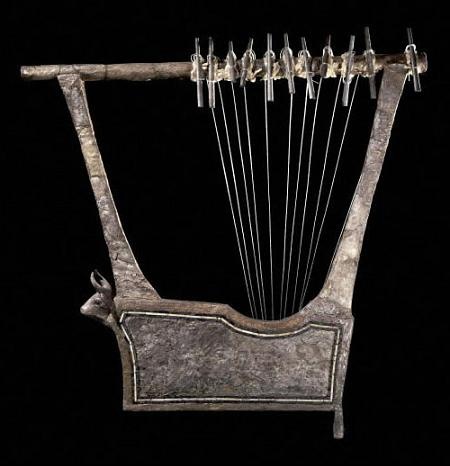Introduction
The discovery of a lyre in the “Great Death-Pit” at the Royal Cemetery of Ur, in southern Mesopotamia (modern-day Iraq), has provided archaeologists and historians with valuable insights into the cultural and artistic sophistication of early Sumerian civilization. This extraordinary find, dating back to the Early Dynastic period (2600–2400 BCE), reveals the importance of music in religious and ceremonial life and offers a window into the beliefs surrounding death and the afterlife in ancient Mesopotamia.
The Royal Cemetery of Ur: A Place of Reverence and Sacrifice
The Significance of the “Great Death-Pit”
The Royal Cemetery of Ur is one of the most significant archaeological sites from early Mesopotamian history. The cemetery contained numerous burials of royals and their retinue, including attendants and soldiers. One of the most notable tombs was the “Great Death-Pit,” where multiple individuals were found, likely sacrificed to accompany royalty into the afterlife. The discovery of musical instruments, such as the lyre, indicates the ceremonial significance of these burials.
This mass grave underscores the depth of Mesopotamian religious beliefs, particularly the idea of a journey into the afterlife where the deceased were surrounded by symbols of status and power, including the presence of live servants and symbolic artifacts like the lyre.

The Lyre: A Masterpiece of Sumerian Craftsmanship
Artistry and Material Splendor
The lyre from Ur is an exceptional example of ancient craftsmanship. It is adorned with gold, silver, and lapis lazuli, materials that signified wealth and divine power in Sumerian culture. The head of the lyre was often shaped like a bull, symbolizing strength and fertility, both of which were highly regarded qualities in Sumerian society.
The detailed craftsmanship not only served as an aesthetic statement but also reflected the value placed on music and art in Sumerian life. The use of precious metals and stones illustrates the instrument’s importance, suggesting that it was likely used in rituals, funerary practices, or royal ceremonies. This lyre was not merely a musical instrument but also a symbol of the divine and the royal household’s power.

The Role of Music in Sumerian Rituals
Music, as represented by the lyre, played a vital role in the lives of the Sumerians. It was believed that music had the power to communicate with the gods and the dead, making it an integral part of funerals and religious ceremonies. The presence of the lyre in the “Great Death-Pit” suggests that music was used to honor the dead, possibly to guide their souls into the afterlife or to soothe them on their journey.
In ancient Sumer, music was also likely associated with both entertainment and ritualistic practices. The combination of fine artistry and the lyre’s religious significance highlights its multifaceted role in Mesopotamian society.

Unveiling the Beliefs of the Afterlife
Human Sacrifice and the Royal Tombs
One of the most striking features of the “Great Death-Pit” was the discovery of numerous human remains, most of whom were likely sacrificed to accompany their king or queen into the afterlife. This gruesome yet telling practice reveals a deeply embedded belief in the importance of royal status even in death. The presence of attendants in death, along with valuable artifacts such as the lyre, points to a belief in a well-ordered afterlife where the royal family would continue to reign.
The lyre, in this context, may have served as a tool for communicating with the afterlife, or as a reminder of the harmonious world that the deceased royals would rule in the next life.

The Power of Musical Rituals in Death
Music’s role in death rituals speaks to the Sumerians’ understanding of life, death, and the transition between the two. Instruments like the lyre were not merely for entertainment but were believed to possess spiritual powers. The lyre’s symbolic association with divinity and royalty suggests that it played a part in the Sumerians’ conception of a cosmic order, where kingship, religion, and the afterlife were all interconnected.
Conclusion
The lyre found in the “Great Death-Pit” at the Royal Cemetery of Ur offers a profound glimpse into the values, beliefs, and artistry of ancient Mesopotamian society. Its intricate design, rich symbolism, and the context of its burial alongside sacrificed attendants emphasize the significance of both music and death rituals in Sumerian life. As an artifact, it continues to inspire admiration and scholarly research, shedding light on the complex world of early dynastic Mesopotamia, where the boundaries between life, death, and the divine were intricately woven together.
By examining such artifacts, we enrich our understanding of ancient civilizations and their enduring legacies in human history.

